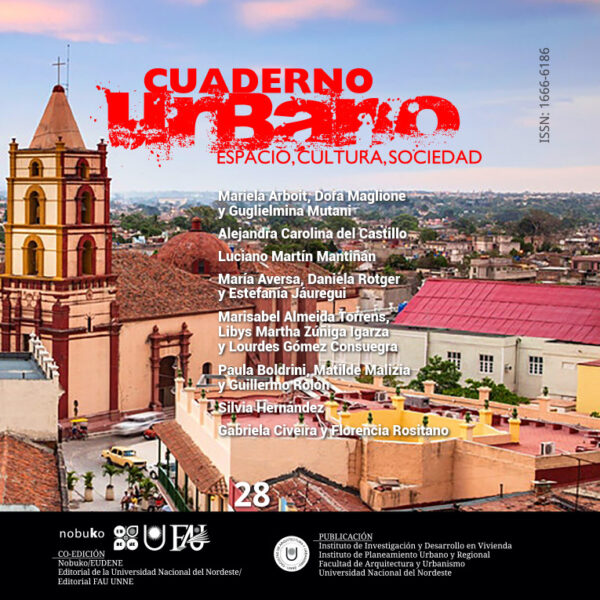Visibilities and invisibilities of risk. The approaches of the graphic media in the flood of april 2013 in gran la Plata
DOI:
https://doi.org/10.30972/crn.28284325Keywords:
Flood, invisibility, graphic mediaAbstract
The extraordinary nature and magnitude of the flood of April 2, 2013 in La Plata, has led to a greater circulation of information about the floods centered in this city. However, the effects of the episode have been made invisible on the coastal municipalities bordering —Berisso and Ensenada—, which have certainly suffered the consequences of the overflow of the water courses that cross their urban core in the direction of their river mouth in the Rio de La Plata.
The main objective of the article is to establish a confrontation of newspaper articles that addressed the event in the three parties of the micro-region during the week after it.The methodological framework is based on the qualitative analysis with the incorporation of quantitative data, through the processing information in tables to quantify and weigh the record, to obtain as a main result, the various approaches made by graphic media about this event.
Downloads
References
(1) Beck, Ulrich (1996). Teoría de la sociedad del riesgo. En Las consecuencias perversas de la modernidad: Modernidad, contingencia y riesgo. Pp. 201-222. Barcelona, España: Editorial Anthropos.
(2) Cardona, Omar Darío (2001). La necesidad de repensar de manera holística los conceptos de vulnerabilidad y riesgo. Una crítica y una revisión necesaria para la gestión. En: International Work-Conference on Vulnerability in Disaster Theory and Practice (Wageningen, 29 y 30 de junio de 2001): Disaster Studies of Wageningen University and Research Centre, Wageningen, Holanda, pp. 1-18.
(3) Facultad de Ingeniería (2013). Estudio sobre la inundación ocurrida los días 2 y 3 de abril de 2013 en las ciudades de La Plata, Berisso y Ensenada. Recuperado de: http://sedici.unlp.edu.ar/handle/10915/27334
(4) González, Silvia; Torchia, Natalia & Viand, Jésica (2015). Inundaciones urbanas y Cambio Climático. Recomendaciones para la gestión. Secretaría de Ambiente y Desarrollo Sustentable de la Nación, Buenos Aires, Argentina.
(5) Herzer, Hilda & Gurevich, Raquel (1996). Construyendo el riesgo ambiental en la ciudad”. En Desastres y Sociedad. Revista semestral de la Red de Estudios Sociales en prevención de desastres en América Latina. Año 4, número 7, pp. 4-15. Ciudad Autónoma de Buenos Aires: Red de Estudios Sociales en Prevención de Desastres en América Latina LA RED.
(6) Indec, Instituto Nacional de Estadística y Censos (2010). Censo nacional de Población y Vivienda. Disponible en: https://www.indec.gov.ar/nivel4_default.asp?id_tema_1=2&id_tema_2=41&id_tema_3=135
(7) Lavell, Allan (1996). Degradación ambiental, riesgo y desastre urbano. Problemas y conceptos: hacia la definición de una agenda de investigación. En: Fernández M. A. (Comp.). Ciudades en riesgo. Degradación ambiental, riesgos urbanos y desastres. Red de Estudios Sociales en Prevención de Desastres en América Latina LA RED-USAID.
(8) Lavell, Allan (2001). Sobre la gestión del riesgo: apuntes hacia una definición. Biblioteca Virtual en Salud de Desastres-OPS. Disponible en: http://www.undp.org
(9) López, Isabel; Etulain, Juan Carlos et al. (2017). Inundaciones urbanas: mapas de riesgo y lineamientos de ordenamiento urbano territorial. En: Ronco, Alicia y López, Isabel. (dir.). Las inundaciones en La Plata, Berisso y Ensenada: análisis de riesgo, estrategias de intervención. Hacia la construcción de un observatorio ambiental. Disponible en: http://sedici.unlp.edu.ar/handle/10915/59633
(10) Maskrey, Andrew (1997). Comunidad y desastres en América Latina: estrategias de intervención. En: Lavell Allan (ed.). Viviendo en riesgo comunidades vulnerables y prevención de desastres en América Latina. Red de Estudios Sociales en Prevención de Desastres en América Latina LA RED-USAID.
(11) Pérez, Rómulo (2013). Redes y centros urbanos bajo riesgo hídrico: prevención y mitigación de desastres naturales en planicies de inundación en la Argentina. Buenos Aires: Eudeba.
(12) Rotger, Daniela Vanesa; Jáuregui, Estefanía & Sanz Ressel, Kuanip (2018). Comunicación y riesgo en el Gran La Plata. En Jornadas Platenses de Geografía y XX Jornadas de Investigación y de Enseñanza en Geografía (La Plata, 17, 18 y 19 de octubre de 2018).
(13) Rotger, Daniela & Sanz Ressel, Kuanip (2016). Paisaje y comunicación social en la gestión del riesgo hídrico. El caso del Gran La Plata. Revista Proyección, Vol. 5, N.º 22, pp. 132-152. Mendoza, Argentina.
Downloads
Published
Issue
Section
License
CUADERNO URBANO sustains its commitment to the Open Access policies for scientific information, on account of the fact that both scientific publications and public funded research must circulate freely on the Internet and without restrictions.
CUADERNO URBANO ratifies the Open Access model in which the contents of scientific publications are available in full text free of charge on the Internet, without temporary embargoes, and whose editorial production costs are not transferred to the authors. This policy proposes breaking down the economic barriers that generate inequities both in access to information and in the publication of research results.





.jpg)








